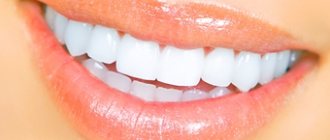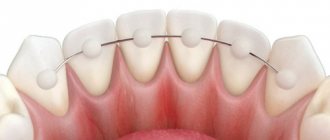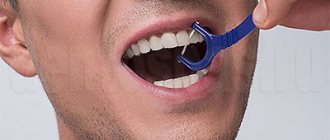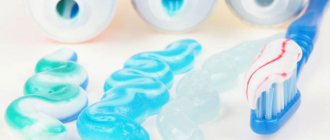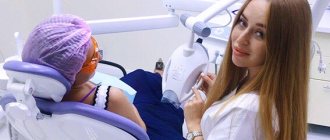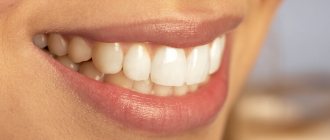Doctors do not recommend storing toothbrushes used by adults and children together. The fact is that most often it is adults who suffer from oral diseases, and storing toothbrushes separately is a means of preventing dental diseases in children. To keep your teeth healthy, dentists recommend changing your toothbrush every three months, as well as immediately after an illness: cough, cold, inflammation of the gums.
An important stage in the dental care process is the use of additional products - dental floss, mouth rinses. Let's tell you more about each option.
Factors affecting dental health
Dentists unequivocally answer that it is possible to maintain dental health only with an integrated approach to solving the issue.
The condition of teeth depends on many factors that affect the functioning of the whole organism, and external influences and the condition of the oral cavity. If you follow all the recommendations, or at least strive for this, you can keep your teeth healthy, white and beautiful for the rest of your life. The health of oral tissues and teeth itself is influenced by the following factors:
- formation of tooth buds in the womb;
- maintaining oral hygiene;
- proper nutrition;
- level of microelements in the body;
- heredity;
- dental diseases;
- systemic diseases;
- external influence;
- prevention of dental diseases.
It is quite difficult to influence the hereditary factor, especially when it comes to serious dental diseases, but dentists recommend paying special attention to prevention and treating pathologies in a timely manner.
Where to go?
Complex dentistry "Sanident" provides a full range of dental services in Ivanteevka and Shchelkovo. In our clinic you will be able to undergo all the necessary procedures, which are carried out at a high level, which is confirmed by the positive reviews of our grateful patients. We employ only the best specialists with many years of experience. High quality service and affordable prices will certainly satisfy your needs, and constant discounts and promotions will pleasantly surprise you.
Complex dentistry "Sanident" is located at the following addresses:
- Ivanteevka, st. Novoselki, 4 (Ivanteevka railway station);
- Shchelkovo, st. Central, 80 (railway station Voronok).
Formation of teeth in the womb
The rudiments of teeth are formed in humans when the general development of the body occurs in the womb. A woman’s behavior and nutrition during pregnancy, as well as the condition of her own teeth, directly affects the health of the child’s dental system in the future. Addiction to bad habits, vitamin deficiency (especially calcium and magnesium), sexually transmitted infections and refusal to treat dental diseases can have a negative impact. If there is a lack of microelements in a woman’s body, pregnant women themselves often face dental problems (bleeding gums, crown destruction, caries formation, etc.). To maintain dental health for a woman and her unborn child, it is necessary to follow all doctor’s recommendations.
If a tooth falls out, you can do just fine without it.
Reality: Each tooth in our wide smile is a link in the dental chain. Each group of teeth performs its own function: some bite off food, others chew it. When a tooth is removed or falls out, the shape of the teeth and jaws changes. The teeth adjacent to the missing one begin to shift and fill the vacated space, which can subsequently cause difficulties with prosthetics.
Fact: Significant tooth loss leads to eating more monotonous and less balanced food, a lack of vitamins and microelements, which can affect brain activity.
What to do?
Lost teeth need to be restored, which can be done in various ways. The options of choice are restorative orthopedic structures supported either by implants or by natural teeth. Fact: The fewer natural teeth a person has, the higher the risk of developing coronary heart disease and heart attack. People with fewer than 10 natural teeth are seven times more likely to die from a heart attack than those with more than 25 teeth.
Proper nutrition
Any dentist, when asked how to keep teeth healthy and strong, will definitely point out the significant impact of the foods consumed on the condition of the oral cavity. To strengthen teeth, it is recommended to include in your diet foods that are rich in minerals such as iodine, fluoride, sodium, magnesium, phosphorus and calcium. Sweet, spicy and sour foods should be avoided. They can be consumed, but in small quantities. You should also limit foods containing dyes. Dentists also pay attention to the consumption of hard foods, which can lead to chips or cracks in the crown. If there is a significant deficiency of microelements, then the deficiency should be filled with ready-made vitamin-mineral complexes.
Rule No. 5. Fluoride
Fluoride is also an essential trace element for our teeth. In the Urals, Mordovia, Moscow and the Moscow region there is enough fluorine in tap water, but St. Petersburg and the entire North-Western region needs an additional source of fluoride. There are now many drugs on the market containing large amounts of fluoride: toothpastes, multivitamin complexes, elixirs, chewing gum. But we must remember that too much fluoride is just as harmful to the body as its deficiency.
Dental diseases
Most oral pathologies can be eliminated at an early stage. Timely treatment of dental diseases is the answer to how you can preserve all your teeth until old age. One of the common causes of dental disease is caries. To keep teeth healthy, it is necessary to begin treatment at the first sign. Such a common pathology as malocclusion also affects the preservation of dental health. Bite correction is considered an effective prevention of many dental diseases.
If you take several x-rays in a row, you can get high levels of radiation
Reality: According to one of the leading specialists in dental radiology, D.V. Rogatskin, one intraoral photograph of a tooth corresponds to approximately one microsievert.
The radiation dose when taking one three-dimensional image on a dental tomograph is approximately equal to the radiation dose from a panoramic image and is about 20-50 microsieverts. What to do?
You should not apply to a peaceful dental office the same concepts that are used at a nuclear test site. During the treatment process, you can and should take as many x-rays as your doctor needs, and if necessary, do not be afraid to do 1-2 studies per year on a dental tomograph. It is necessary to understand that your attending physician takes a picture, or a series of pictures, so that the quality of treatment is at the proper level and the tooth will serve you for many more years. And such a modern method as tomography of the maxillofacial area goes beyond the boundaries of conventional x-ray examination and often allows the doctor to see in volumetric form the pathology that cannot be determined on ordinary photographs.
Prevention
Many people know what preventive measures exist to preserve teeth. However, not everyone adheres to dentists' recommendations. To keep teeth and gums healthy until old age, oral hygiene alone is not enough. You should visit the dentist's office for a preventive examination at least 2 times a year. It is advisable for children to undergo a medical examination every 4 months. Preventive measures include all the recommendations described above, including professional teeth cleaning.
Dentist advice
Doctors emphasize that you need to carefully take care of your oral health and brush your teeth in a timely manner. A high level of hygiene is the basis without which nothing can be achieved at all. If plaque is not removed in a timely manner, thinned enamel, loosening of the molar units, hyperesthesia, and gingivitis will not take long to occur.
At the same time, it is not enough to just brush your teeth in the morning and evening - you need to do it correctly. During the procedure, you should use a high-quality brush and paste (it’s good if your dentist selects them).
To the aid of sensitive and caries-prone units come:
- rinses with anti-inflammatory activity;
- strengthening gels;
- floss;
- professional hygiene.
External factors
It is impossible to keep tooth enamel white and the teeth themselves healthy if there is a negative external influence. Such factors include addictions (taking drugs, smoking cigarettes and drinking alcohol), bad habits (biting nails, objects, solid foods, chewing gum or sucking fingers, lollipops, etc.) the effect of chemicals on the body (self-bleaching, working on production or living in a high-risk area), constant hypothermia, etc.
How to keep your teeth healthy and beautiful throughout your life? Dentists give a clear and concise answer: it is necessary to adhere to a healthy lifestyle, regularly visit the dentist and promptly treat dental and other diseases. Children should be taught to monitor the condition of their teeth from an early age, and adults should find time to follow all doctor’s recommendations.
Why is there a need to strengthen enamel?
Caries is one of the most common problems that dentists have to deal with. It is because of its frequent occurrence that many people are forced to look for ways to strengthen their teeth. The disease is caused by:
- genetic predisposition to an abnormal process;
- disruptions in the functioning of the endocrine system;
- severe pathologies of the stomach and intestines;
- untimely removal of soft plaque and hard stone;
- non-compliance with dental cleaning techniques;
- refusal to eliminate non-carious enamel lesions;
- pathological abrasion;
- incorrect bite, due to which it is impossible to properly clean individual interdental areas;
- poor diet, habit of eating a lot of sour and sweet foods;
- alcohol abuse, tobacco addiction;
- habit of chewing foreign objects.
Often the enamel is greatly weakened due to hormonal changes. This is why many expectant mothers become patients in dental clinics.
Features of the structure of newly erupted permanent teeth in children.
As we have already said, newly erupted permanent teeth in a child have a number of anatomical features and differ from the teeth of an adult, namely:
- They have fragile, not fully formed and mineralized enamel.
- They have unformed roots that connect to the growth zone.
- The root canals of such teeth are wide, with a funnel-shaped expansion towards the root apex.
- The thin and fragile walls of the dental canals do not have secondary dentin; they are easily injured and destroyed.
- There is insufficient mineralization of dentin in the roots of the tooth.
Therefore, when treating pulpitis of permanent teeth in children, there are a number of limitations and features that the pediatric dentist knows and must follow. Endodontic treatment (root canal treatment) of permanent teeth in children is complex and requires great care.
By the way, for this reason, it is better for adolescent patients to contact a pediatric specialist rather than an adult dentist-therapist.
Pain from cold
Increased sensitivity of enamel to irritants is called hyperesthesia. Toothache in adolescents, as a manifestation of hyperesthesia in response to temperature exposure, develops due to easier transmission of impulses to the pulp, the sensitive part of the tooth, which contains nerve fibers. This happens as a result of numerous processes leading to a decrease in the protective properties of enamel. This can be caries and non-carious lesions of tooth tissue.
The second reason for pain from cold and hot is the exposure of the neck and root of the tooth when the gums sag. In the root area, the layer of enamel is much thinner than in the coronal part. Dystrophic processes in periodontal tissues quickly lead to the destruction of the periodontal junction and exposure of sensitive areas of the teeth.
Other important features of the treatment of pulpitis in permanent teeth for children under 14 years of age:
In order for the treatment of pulpitis to be successful and the patient to have no relapses or complications, it is necessary to:
- Strictly maintain sterility to avoid infection during treatment.
- Use a rubber dam to isolate the patient’s oral cavity from the manipulation field.
- Carry out a thorough filling of the canals - the voids left in them will provoke the re-development of inflammation.
- Monitor the quality of canal filling after treatment using repeated x-ray diagnostics.
- Do not forget that not only adults, but also children need high-quality fillings and dental restoration, and, sometimes, even prosthetics with ceramic inlays.
Problems with removing braces
Locks that are firmly fixed with adhesive can be removed during or after orthodontic treatment. This can be done using a special tool that deforms the bracket and detaches it from the tooth surface. The procedure requires pinpoint precision from the orthodontist, otherwise the integrity of the tooth tissue can be damaged and the enamel can be damaged, causing cracks to form.
Chips, cracks and any other enamel defects are the “entrance gate” for the infection that causes caries. Even if the cracks are superficial and do not reach the dentin, food debris, bacteria, and dental deposits accumulate in them. In such a situation, tooth tissue is quickly destroyed with the formation of a carious cavity. Areas of enamel damage also become a factor in the development of increased tooth sensitivity to temperature influences. The first manifestation of the complication is the appearance of pain while eating cold food and drinks.
Strengthening techniques used in dentistry
Experienced dentists use highly concentrated products enriched with minerals when working with “problem” teeth. Additionally, they prescribe fluoride-containing pastes and remineralizing gels to patients, which can be used at home.
This is the name of the most effective dental procedures to strengthen teeth:
- Remineralization. First, professional hygiene is carried out. Using an ultrasonic scaler, the doctor cleans the crowns of deposits. After this, it covers them with a special remineralizing composition. Prepared enamel absorbs beneficial components like a sponge. Due to this, her condition improves. It becomes dense, very hard and perfectly smooth. In advanced cases, one remineralization session may not be enough. Then it is repeated two to four times at certain intervals.
- Fluoridation. Often this type of treatment is combined with remineralization. This is due to the fact that fluoride is better absorbed after calcium. Fluoridation means the treatment of hard dental tissues with a fluoride-containing preparation. It quickly penetrates into the deep layers of the tooth and saturates its tissues, making them more resistant to negative external factors. It is especially important to undergo fluoridation twice a year for people who live in regions where the water flowing from the taps is low in fluoride compounds.
